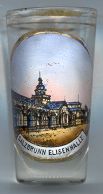

|
| POLSKA | POLAND |
| województwo: Dolnośląskie | voivodship: Lower Silesia |
| powiat: Wałbrzych | county: Wałbrzych |
Szczawno-Zdrój is situated at an elevation of 410 m at the foot of the Chełmiec mountain, the highest elevation (810 m) of the Waldenburg mountains (Wałbrzyskie Góry), just west of the county seat, Wałbrzych (Waldenburg).
 Salzborn was first mentioned in a document of 1221. After the death in 1368 of the last Duke of Świdnica-Jawor
(Schweidnitz-Jauer) it fell to the Bohemian Crown, but was held by the duke's widow until 1392.
Ruled by Bohemian governors residing at Książ Castle, the area was devastated during the
Thirty Years' War (1618–1648). The first description of the therapeutic properties of the mineral springs of
Ober-Salzbrunn date from the late 16th century. After the First Silesian War, the town became part of Silesia in
1742. The development of the spa began fro 1815 onward. Numerous famous people visited the spa, among them members of the
Prussian royal family. In 1935, Ober-Salzbrunn was renamed Bad Salzbrunn.
After World War II it became part of Poland and obtained the official status of a town under the name
Solice-Zdrój. In 1946 it was finally renamed Szczawno-Zdrój.
Salzborn was first mentioned in a document of 1221. After the death in 1368 of the last Duke of Świdnica-Jawor
(Schweidnitz-Jauer) it fell to the Bohemian Crown, but was held by the duke's widow until 1392.
Ruled by Bohemian governors residing at Książ Castle, the area was devastated during the
Thirty Years' War (1618–1648). The first description of the therapeutic properties of the mineral springs of
Ober-Salzbrunn date from the late 16th century. After the First Silesian War, the town became part of Silesia in
1742. The development of the spa began fro 1815 onward. Numerous famous people visited the spa, among them members of the
Prussian royal family. In 1935, Ober-Salzbrunn was renamed Bad Salzbrunn.
After World War II it became part of Poland and obtained the official status of a town under the name
Solice-Zdrój. In 1946 it was finally renamed Szczawno-Zdrój.
The Polish pianist Henryk Wieniawski toured here in 1855–1857. Since 1966 an annual music festival, named for him (Festiwal Henryka Wieniawskiego), takes place here.
The German playwright Gerhart Hauptmann (1862–1946) was born here. Hauptmann received the Nobel Award for Literature in 1912.
The pump room  Elisenhalle [left] was originally built in 1830, and was
rebuilt in 1893.
Elisenhalle [left] was originally built in 1830, and was
rebuilt in 1893.
[https://de.wikipedia.org/wiki/Szczawno-Zdrój, https://en.wikipedia.org/wiki/Szczawno-Zdrój, https://pl.wikipedia.org/wiki/Szczawno-Zdrój]
![[scale]](lineal.jpg)